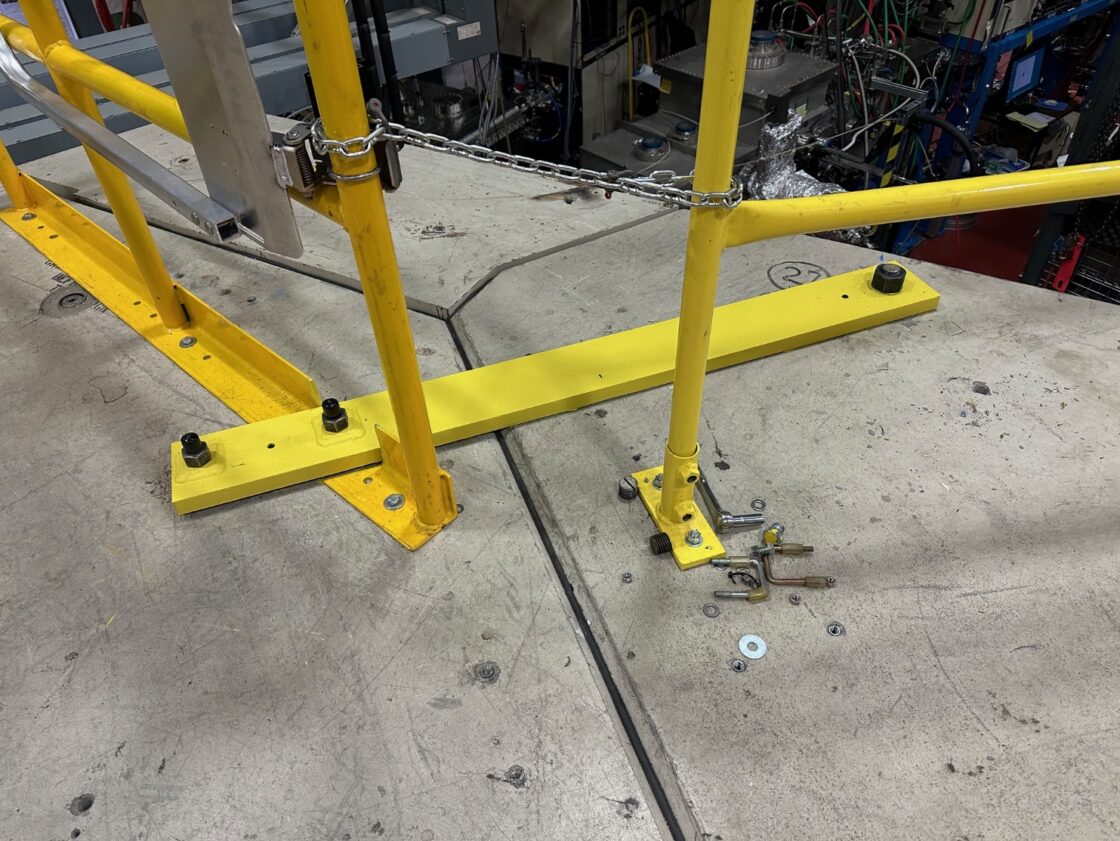by Ina Reichel
The ALS is back in user operation after more than two months of shutdown. A lot of the work centered around the accumulator ring (AR) installation, but the new booster ring bend magnet power supply was also installed.
Accumulator ring and other ALS-U work

The biggest item (at least in terms of volume) is the new power supply for the booster bend magnets. Recent visitors to Beamline 5.4 will have noticed big changes in the booster pit. The new power supply has been mechanically installed, and the electrical installation is still ongoing. The current power supply allows the booster ring to ramp up to a beam energy of 1.9 GeV. The power supply ramping up creates a “chirp” that can be heard on top of the booster ring every 1.5 seconds while the booster is running. For ALS-U, the booster ring needs to ramp to 2.0 GeV. This new power supply will allow that.
The two power supplies for the AR radio frequency system were installed on top of the booster ring, another visible sign of dark time inching closer. The manifolds that will connect them to the low conductivity cooling water system were installed as well.
A number of pieces for ALS-U were installed inside the tunnel as well. The first kickers that will be used for ALS-U were installed in the current storage ring so that the setup can be tested. Kickers are magnets that can switch on and off very rapidly. They are required in storage rings to be able to inject beam. “Initial tests with full beam current show that the temperature rise of the kicker ceramic from beam heating is several degrees Celsius,” said Will Waldron, the technical lead for the ALS-U Injection and Extraction group. “That’s consistent with modeling results.” Elizabeth Lee, the manufacturing engineer who led the kicker installation, added, “This validates the design and gives the project confidence that we will be well prepared for the installation of the kicker into the new accumulator ring during the upcoming summer shutdown.”
AR dipole magnets and magnet rafts were installed, and for the first time, adjacent AR vacuum chambers were connected to each other.

A new custom walk-under wireway was installed in Sector 11 of the storage ring, significantly increasing the length of the duck-under. This additional wireway will allow the multitude of new ALS-U cables to pass through that area. They would not have been able to fit into the existing wireway underneath the floor.
Seismic upgrade and ALS work
Building on work in previous shutdowns, more elements required for the seismic upgrade of the storage ring tunnel were installed. The types vary, with approximately 500 elements in total being required. One such element stabilizes the connection between roof blocks (see picture). After this shutdown, the project is now about 25% complete. Work will continue every shutdown and will conclude in the ALS-U dark time.
The team also replaced a broken thermocouple within the vacuum chamber of a bend magnet in the storage ring. This particular thermocouple is used to monitor for temperature increases in the delicate chamber in the rare instance of missteered synchrotron radiation. “This thermocouple is very delicate, embedded deep in the vacuum chamber and enclosed within a particularly fragile section,” said Accelerator Operations and Development Deputy Simon Leemann. “That makes its repair so complicated and required the mechanical technician crew to disassemble and remove the complete bend magnet around the chamber,” he explained.

After installing a new master oscillator for the rf system during the recent summer shutdown, new wave guides were installed to connect it to the rf system of the storage ring. The new wave guides take a different path, no longer restricting the height of the main walkway in the storage ring tunnel.
The multitude of installations during this shutdown brought the facility closer to commissioning the accumulator ring. And whereas most shutdown work has typically taken place inside the storage ring tunnel, this shutdown’s work included major and highly visible installations in the booster pit and on top of the booster ring. From the gargantuan power supplies to the nuts and bolts of the seismic plates, the projects wrapped up on time thanks to the team’s hard work. “I always say it takes a village to run a place like the ALS,” stated ALS Deputy for Business Operations Steve Rossi. He continued, “Between ALS, Engineering and ALS-U staff, contractors, and Lab operations groups, over 150 individuals contributed to yet another successful ALS shutdown. It makes me proud to think about it.”